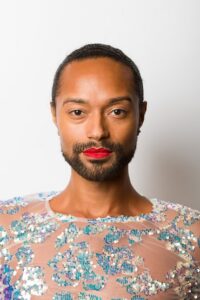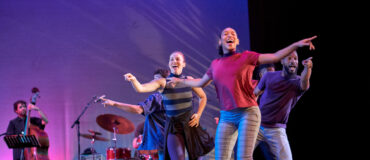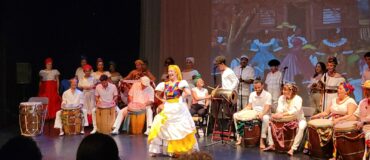By Abdiel Jacobsen
Abdiel Jacobsen is a 2023 Archiving and Preservation Fellow with Segunda Quimbamba Folkloric Center. Read more about the Fellowships here. This is the first part of Abdiel’s blog. Read the second part here.
En Route to Segunda Quimbamba Folkloric Center (SQFC)
Segunda Quimbamba Folkloric Center is a nonprofit cultural arts organization that preserves and celebrates the Puerto Rican Folkloric drum music Bomba and Plena through education and live performance via their dance and percussion ensemble, 2Q. For over 30 years, SQFC has been a cultural hub for the Jersey City Puerto Rican community to gather, exchange, practice, learn, and celebrate their folkloric music and dance traditions.

The vacant retail space
I began my route to SQFC in Jersey City–about an hour away from my Harlem home–eager to be introduced to the center, meet again the founders and directors, Juan Cartagena and Nanette Hernandez, and learn more about their archive to plan next steps for our archiving fellowship with Dance/USA. When getting off at Grove Street from the PATH train, the area was busy with pedestrian traffic. There were many skyscrapers in the near distance. There were lots of shops, boutiques, and restaurants—Shake Shack, Bareburger, and Two Boots Pizza were in the same vicinity. It had a downtown vibe within a residential area. I had been to this area before years ago and did not remember it being so busy with shops and its current commercialized appeal. Streets were now blocked off from any thruway traffic. I immediately felt a sense of gentrification. Later that day on my lunch break, Juan Cartagena took me through the Grove Street area and mentioned how gentrified it was. We passed a vacant storefront on Newark Avenue sandwiched between two tall buildings in the hot spot of Jersey City’s historic district. He said it used to be a hardware store called “Downtown Hardware” owned by a Puerto Rican family for over twenty years. 2Q used to perform in front of the hardware store—they haven’t since the Puerto Rican owners left.

Grace Church
When I turned at SQFC’s block (about a 10 minute walk from the train stop) there was quite a bit of construction happening on the road, which Juan and Nanette later told me had been happening for over a year. I had passed two churches on the same block as SQFC, Grace Church (Episcopal) and Saint Mary’s Parish. Jehovah’s Witnesses were proselytizing on the opposite block with the Kingdom Hall around the corner; I could sense a strong religious community presence. Later, I would learn that Grace Church was a location where 2Q would perform in the early years of the company’s operation. They had a good rapport with each other. In addition, 2Q has collaborated with Baptist choirs fusing gospel with Bomba and Plena.
Arrival
SQFC is on a residential block since the center is in Juan and Nanette’s home. The signage is small, discrete, and quaint, sparking my curiosity to find out what was inside. I went a few stairs down to the main door. I was welcomed with warm, open arms by Juan and Nanette. We sat down and had coffee and immediately got to chatting. They mentioned different spaces that they have been using for rehearsals and classes along with their own space over the past two decades: Jersey City Museum, Cobra Fencing Club, Mana Contemporary Art Museum, and Nimbus Arts Center (where they are currently). We learned that we both know well the founding artistic director of Nimbus Arts Center, Samuel Potts, whom I danced with at the Martha Graham Dance Company. They also shared performance and educational sites outside of Jersey City that the SQFC has participated in such as Hostos Community College in the Bronx, which hosted one of the largest Bomba festivals in the nation called “BomPlenazo.” SQFC would attend and participate in the culminating performance of that festival at Rincón Criollo, more popularly known as “La Casita de Chema”—translated as “Chema’s Little House”—”la casita” being a cultural iconography of Puerto Rican intimate community gatherings. 2Q has traveled back and forth between Puerto Rico and New Jersey for various performances and festivals and internationally to locations such as Spain and Barbados. One that stood out for Juan and Nanette was Puerto Rico’s most famous and largest event for Bomba in Cataño called “Encuentro de Tambores.” At this festival it is common to have hundreds of drums playing all at once!

Abdiel in front of SQFC (2Q is the nickname for Segunda Quimbamba, the company housed at the folkloric center)
Next, Juan and Nanette gave me a tour of their home. They mentioned that it is an old convent converted into a house and they have some of the original stained glass from the arched windows in the backyard. Their home has four floors; the ground floor being the SQFC main office, where they hold rehearsals and classes, and the above floors are their living area—the second floor also hosts music classes sometimes. The walls of their home are filled with vibrant posters, traditional African and Puerto Rican masks, and striking paintings and drawings. The ground level is where they hold most of their paper archival materials already stored in file cabinets. During the pandemic they used both the ground level and first level to teach classes online.
Juan and Nanette have two children, Rosa (Bomba dancer and musician) and Mateo (punk rock musician). Both are performing artists who have performed with 2Q, and Rosa still currently performs with the company. You can tell that art was an integral part of their household and nurtured throughout their upbringing. The Puerto Rican cultural traditions and practices are deeply rooted in their family. They have a beautiful garden in their backyard with grass, trees, plants, and flowers which Nanette planted herself with help from friends. It has a peaceful, calm vibe to it—a hidden oasis from the city atmosphere. It made me think of the casita they mentioned before; maybe their place could become one—“La Casita de 2Q.”

The backyard
A Lecture in Music of the Puerto Rican Diaspora
After getting a tour of the house, we sat down in their office and Juan gave me a lecture from a PowerPoint presentation he created on music of the Puerto Rican diaspora. I learned that there are four major types:
Bomba (1600s) – The oldest folkloric musical genre, Bomba is a music derived from West and Central Africa and likely remnants of Taino performative practices. Bomba must consist of at least 2 barril (barrel) drums, 1 maraca, and cua (pair of sticks to hit on any surface, usually another barrel). In addition, there must be a dancer present to engage in a call and response practice between the primo drummer who responds to the movements initiated by the dancer. The rhythms that correspond to Bomba include, but are not limited to: yubá, sicá, holandés, cuembé, seis corrido, rulé, and corvé.
Danza (mid-late 1800’s) – The danza of Puerto Rico is a musical genre that more closely approximates the classical, salon music of Europe which it was mainly influenced by, with shades of Bomba percussive patterns mixed in. It is music you generally dance to with a partner in a dance hold like European ballroom dance.
Música Jíbara (early 1900’s) – Known as the mountain music of Puerto Rico, música jíbara is identified by its seminal instrument the cuatro guitar, along with the guiro. It is primarily performed during the winter holiday season starting in November and through January. It was introduced into salsa music by way of Willie Colón (trombonist), Héctor Lavoe (singer), and famous cuatro player, Yomo Toro—all of Puerto Rican descent.
Plena (early-mid 1900’s) – The youngest diasporic musical genre, Plena must consist of the pondero and guiro and commonly consists of the bombo drums, cow bell, clave, guitar, and accordion. It doesn’t require a dancer to be present, unlike Bomba. It is a musical style that is also mobile and can be played in street celebrations such as parrandas during the holiday season. Its lyrics are discussions of contemporary everyday life matters—struggles, gossip, celebrations, and so forth.

Journals of La Música de Puerto Rico: Raíces and Evolución by William Cepeda
I was struck that the first recordings of música jíbara and danza were made in NYC. It emphasized the significance of NYC as a central site within the Puerto Rican diaspora for Puerto Rican folkloric music and its proliferation. This caused many influential Puerto Rican musicians to travel to NYC, creating an undeniable connection of Puerto Rican folkloric music and its contemporary development within the U.S. American diaspora. Juan and Nanette also pointed out that because of the diaspora, communities outside of Puerto Rico may not have access to traditional costumes or may only have female practitioners available to play drums. In addition, social values in various cosmopolitan areas may hold various perspectives of gender roles that advocate gender equality and promote a costuming that represents an urban aesthetic. Due to their position away from traditionally held values on the island–although they do show up in Puerto Rico as well–it is easier to practice non-traditional presentations of Bomba and Plena. Nowadays, it is not unusual to see dancers both on the island and in the diaspora performing in everyday casual wear without the traditional dresses and skirts, or women playing the drums. There are several all-female bomberos, including the main primo lead drum, and even queer identifying bomerxs and plenerxs claiming their spot on the batey. Juan and Nanette have embraced and nurtured all of these non-traditional elements in their company and at their center promoting the evolution of the form and culture.
After the presentation, they showed me videos of the company performing. The company is a multi-generational group of men and women spanning from 13 years old to over 70 years of age. There was such joy, vigor, and passion portrayed through the sonic exclamations of the various percussion instruments, vocal belts of the singers, and polycentric body amalgamations of the dancers. Juan and Nanette proceeded to teach me how to play the pondero; a hand drum like a tambourine but without the metal jingles. With each of us holding a pondero—Juan with the small size, me with the medium size, Nanette with the large size—we synchronized to a polyrhythmic pulse of Plena. I couldn’t help rocking side to side to the energizing yet soothing tone of the drumhead. Nanette proceeded to get up and demonstrate some of the movements that go along with Plena. It reminded me of the same West African movements I grew up doing under the tutelage of my mother and at West African social events. They moved to the barril drums and began to play and dance various Bomba rhythms. I continued to follow along with Nanette each movement pattern and the various spinal inflections created through the torso in connection to the feet, legs, hips and shoulders. All of it felt so familiar. I kept feeling a calling from my heart that this is home. Even dancing in the living room—the site where I began my dance journey—recalled memories of me dancing with my two older sisters and my mother in our living room to Ivorian music, both traditional and contemporary, following the lead of my mother as she grabbed her handkerchief and began improvising her cultural movements.
Nanette demonstrated the playful exchange of dancers with the primo. With every physical gesture, Juan would anticipate accenting the movement with just the right inflection at the same exact time (ideally). Nanette would sometimes go right up to him as if to check if he could really see her or make sure he was paying attention by going in an opposite direction unexpectedly. This spontaneous interaction made for a teasing interchange, keeping the primo hyper focused on the dancer and the dancer tantalizing and toying with endless possibilities of spatial rhythmic shaping. Nanette encouraged me to try after she and Juan so masterfully demonstrated. I was so nervous at first. I am used to listening to the music and reacting to what I hear; in this scenario the musician was waiting to react to me. I felt a great sense of power and authority to command aural composition right in the moment. I was the conductor and composer simultaneously. I kept my accent simple yet with each strike of the barril, I felt a surge of energy vibrate from the drum to my bones and the conversation continued as long as I wanted it to. I left the SQFC empowered by the ancestral technologies of rhythm and movement that had my bodily intuitive senses stimulated into a vibratory zing. We decided the next day I would begin inventory of all their archival materials. I couldn’t wait to return!
Header image: Dancer: Kiera Colon, 2Q Spring Recital, June 5, 2022. Photo credit: Mimi Montalvo
All other photos courtesy of the author.
 Abdiel Jacobsen (they/them) is a Hustle dance champion, educator, and community organizer dedicated to the cultural preservation and creative expansion of the New York Hustle partner dance style. As co-founder of “Dance is Life”–a communitarian free public dance party event– Abdiel creates space to facilitate human connection, communal healing, and celebration while revitalizing cultural historical sites where Hustle has been traditionally danced. Abdiel currently teaches their gender neutral approach to partner dance as a Pre Doctoral Lecturer at the University of Washington. They are also a former Fulbright Specialist with the US Dept. of State, Bureau of Educational and Cultural Affairs and a former Principal dancer of the Martha Graham Dance Company. Abdiel is looking forward to deepening their archival practices through the collaboration of the Segunda Quimbamba Folkloric Center and creating communitarian protocol for outreach, collection, and cataloging of crowdsourced materials. For more information on Abdiel: Instagram. Photo Credit: Warren Woo.
Abdiel Jacobsen (they/them) is a Hustle dance champion, educator, and community organizer dedicated to the cultural preservation and creative expansion of the New York Hustle partner dance style. As co-founder of “Dance is Life”–a communitarian free public dance party event– Abdiel creates space to facilitate human connection, communal healing, and celebration while revitalizing cultural historical sites where Hustle has been traditionally danced. Abdiel currently teaches their gender neutral approach to partner dance as a Pre Doctoral Lecturer at the University of Washington. They are also a former Fulbright Specialist with the US Dept. of State, Bureau of Educational and Cultural Affairs and a former Principal dancer of the Martha Graham Dance Company. Abdiel is looking forward to deepening their archival practices through the collaboration of the Segunda Quimbamba Folkloric Center and creating communitarian protocol for outreach, collection, and cataloging of crowdsourced materials. For more information on Abdiel: Instagram. Photo Credit: Warren Woo.
____
We accept submissions on topics relevant to the field: advocacy, artistic issues, arts policy, community building, development, employment, engagement, touring, and other topics that deal with the business of dance. We cannot publish criticism, single-company season announcements, and single-company or single artist profiles. Additionally, we welcome feedback on articles. If you have a topic that you would like to see addressed or feedback, please contact communications@danceusa.org.
Disclaimer: Opinions expressed in guest posts do not necessarily represent the viewpoints of Dance/USA.




